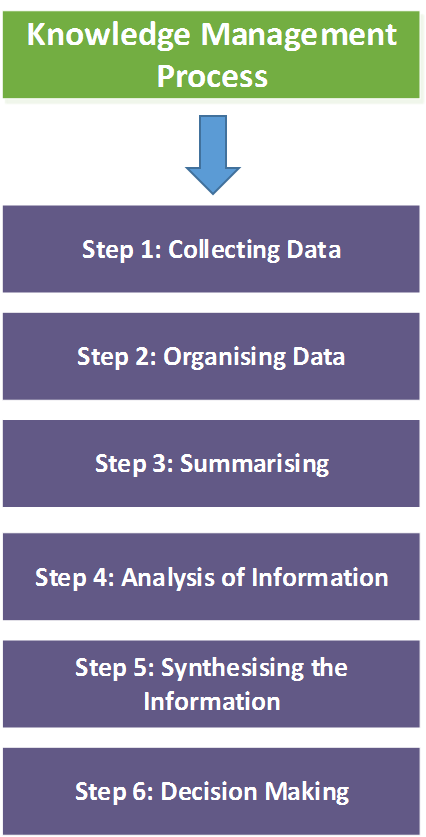The process of knowledge management is universal in nature. The resources used by organisation like machine, equipment, technology etc. could be unique at different points of time. With the help of various tools and technologies, there are six basic steps in the knowledge management process. If this whole process is gone through each Step in a sequence then it transforms data into knowledge.

Step 1: Collecting Data: In the process of knowledge management, collection of data is first and most important step. In case the collected data is incorrect Or inappropriate the Outcome of process will be incorrect. Therefore, decisions which are taken on the ground of this knowledge will also be wrong. A number of tools and techniques are used for the collection of data. Firstly, collection of data must be a process under the knowledge management process. This collection of data must be done With proper evidence or proof and the entire process of data collection must be followed by each person involved in it. Together with data collection point. data extraction tools and techniques and data storage are also described. For example, sales report will be paper-based where the data is fed manually to the database by a data entry operator. On the other hand, the daily attendance report might be an online report storing data straightaway in the database. For this purpose, these days mostly organisations are using software database application.
Step 2: Organising Data: The data collected under first step is needed to be systematically organised. Organisation defines some specific rules under which collected data is organised. If the database has a lot of data then techniques like ‘normalisation’ are applied to organise and eliminate duplication. Hence, data is logically arranged and is connected with one another for the purpose of easy recovery. When any data goes through this step then it transforms into information.
Step 3: Summarising: Under this step the entire information is studied and a summary of most important facts is prepared. The summary of whole information is diagrammatically presented and is stored properly. Several tools like cause and effect, Pareto-charts. packages and various techniques are available for summarising information.
Step 4: Analysis of Information: After summarising the information it is analysed. Under this step, analyst seeks for different relationship and patterns. This is a very important step where experience plays a key role hence either an experienced person or team must be appointed to analyse the data in most appropriate way. Mostly, reports are prepared after the information is analysed.
Step 5: Synthesising the Information: At this Step, information is transformed into knowledge. The outcomes of analysis are shafted together in order to get various new concepts and products. The behaviour of a unit can be used to demonstrate the other. Further, there could be various elements of the knowledge which can be used throughout the organisation. Then this knowledge is kept and preserved in the knowledge base of the organisation for its use in future. Generally, the software of this knowledge base can be reached easily from anywhere with the help of internet. Such knowledge based software can also be bought by any person or its open source implementation can be downloaded for free.
Step 6: Decision Making: This is the last stage, under this step the prepared knowledge will be used for making important decision. For example, while forecasting about specific task knowledge related to similar past projects can be used. This not only helps in forecasting easily but it also helps in making correct forecasts. In this manner knowledge management of the organisation saves money and adds value in the long term.